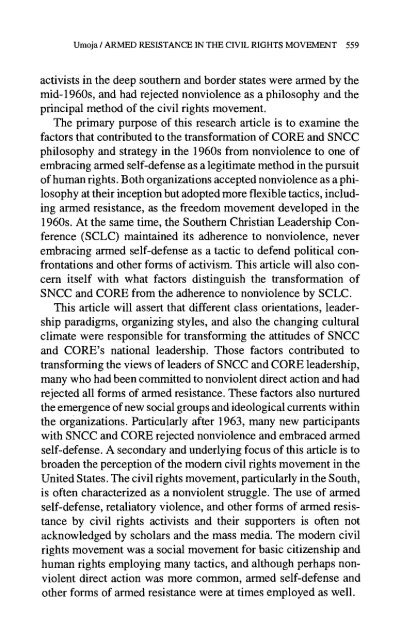MXGM Self-Defence Manual
MXGM Self-Defence Manual
MXGM Self-Defence Manual
You also want an ePaper? Increase the reach of your titles
YUMPU automatically turns print PDFs into web optimized ePapers that Google loves.
Umoja / ARMED RESISTANCE IN THE CIVIL RIGHTS MOVEMENT 559<br />
activists in the deep southern and border states were armed by the<br />
mid-1960s, and had rejected nonviolence as a philosophy and the<br />
principal method of the civil rights movement.<br />
The primary purpose of this research article is to examine the<br />
factors that contributed to the transformation of CORE and SNCC<br />
philosophy and strategy in the 1960s from nonviolence to one of<br />
embracing armed self-defense as a legitimate method in the pursuit<br />
of human rights. Both organizations accepted nonviolence as a philosophy<br />
at their inception but adopted more flexible tactics, including<br />
armed resistance, as the freedom movement developed in the<br />
1960s. At the same time, the Southern Christian Leadership Conference<br />
(SCLC) maintained its adherence to nonviolence, never<br />
embracing armed self-defense as a tactic to defend political confrontations<br />
and other forms of activism. This article will also concern<br />
itself with what factors distinguish the transformation of<br />
SNCC and CORE from the adherence to nonviolence by SCLC.<br />
This article will assert that different class orientations, leadership<br />
paradigms, organizing styles, and also the changing cultural<br />
climate were responsible for transforming the attitudes of SNCC<br />
and CORE's national leadership. Those factors contributed to<br />
transforming the views of leaders of SNCC and CORE leadership,<br />
many who had been committed to nonviolent direct action and had<br />
rejected all forms of armed resistance. These factors also nurtured<br />
the emergence of new social groups and ideological currents within<br />
the organizations. Particularly after 1963, many new participants<br />
with SNCC and CORE rejected nonviolence and embraced armed<br />
self-defense. A secondary and underlying focus of this article is to<br />
broaden the perception of the modern civil rights movement in the<br />
United States. The civil rights movement, particularly in the South,<br />
is often characterized as a nonviolent struggle. The use of armed<br />
self-defense, retaliatory violence, and other forms of armed resistance<br />
by civil rights activists and their supporters is often not<br />
acknowledged by scholars and the mass media. The modem civil<br />
rights movement was a social movement for basic citizenship and<br />
human rights employing many tactics, and although perhaps nonviolent<br />
direct action was more common, armed self-defense and<br />
other forms of armed resistance were at times employed as well.


